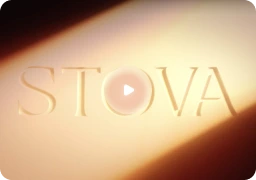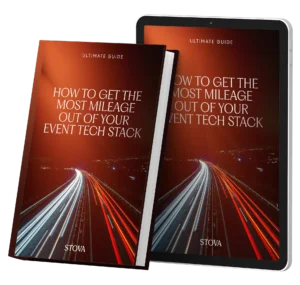How to Improve Your Trade Show ROI
April 6, 2023
Though event technology has changed drastically in the last decade, there’s no denying that in-person interactions remain the most impactful way for marketers to forge, build and nurture meaningful relationships with prospects and customers. That’s why focusing on trade show ROI is incredibly important. Exhibitors should emphasize making their booth as memorable and welcoming as possible so that it exemplifies their brand and makes a positive impression on visitors. And, event organizers should do their part to implement tools and technology that makes this easier for exhibitors. Here’s how to maximize the impact of a trade show booth and improve your trade show ROI.
What Is a Trade Show?
Trade shows, or trade show exhibitions, are organized events through which businesses from the same industry gather to showcase their latest products or services to potential customers. Often, they involve an expansive trade show floor in a convention center or hotel, complete with booths that go above and beyond to grab attention: Think extravagant displays, games, swag, and even food and drink for visitors who stop by. The global trade show market revenue is more than $50B, and the B2B trade show market value in the United States is over $10B. While trade show strategy took a back seat during the pandemic, when groups were not meeting up in person, this type of event is back in force, with industry experts predicting a full recovery for the trade show industry by 2024.

How to Increase Trade Show ROI
The first step toward increasing your trade show ROI is to clearly define your trade show marketing goals and carefully research and identify which trade shows would be the best fit for your brand, including B2B trade shows with the most potential to drive customers and sales. Once you’ve determined where you want to invest in trade show strategy, here are specific ways to look at increasing the ROI of your trade show exhibitions.
1. Think through your pre-show strategy.
Even the most state-of-the-art trade show booth won’t wow attendees if you haven’t developed content to get them excited about seeing and visiting you on the show floor ahead of time. Demonstrate the value they’ll get from stopping by in person through connecting before the show to schedule appointments. (Pro tip: Share a calendar invite as soon as they agree, as people are less likely to skip out on your booth if they already have you on their schedule). In the days leading up to the trade show, clearly communicate where visitors can find your booth on the floor and promote details of any exciting happenings — such as giveaways, demonstrations or contests — so they can plan to show up. Don’t forget to engage with attendees on social media, too. Find out from the event organizer about any hashtags they’re using throughout the trade show, and use these to connect with attendees posting about the event ahead of time as well as to promote your booth.
2. Build media connections.
You’re at the trade show to connect with business prospects and current customers, but don’t forget about another influential group of people who will likely be on the show floor: members of the media. This includes reporters from local, regional and potentially national outlets, depending on the show, along with freelance writers, editors, bloggers and influencers in your industry. Through storytelling on their respective outlets and platforms — whether that be a print publication, digital site, social media page or something else — their coverage of the event and your brand’s presence there has great potential to spread the word about your company. Don’t wait until show time to connect with media, though. Ask your event organizer if they can share a list of participating media and reach out to them ahead of time. Requesting interviews or demos is fine to do, but also offer up the opportunity to just stop by and say hello. Some media may feel more comfortable conversing in a casual setting and be more likely to do a story about you if they don’t feel pressure to immediately do an interview. Don’t forget to follow up with each media connection after the show, too, and focus on building relationships with them.
3. Plan giveaways and enticing reasons to visit your booth.
Who doesn’t love winning a prize? Sure, it’s nice to hand out branded swag, but think beyond typical pens and water bottles to offer something more exciting. Also make your booth more compelling to visit by offering the chance to win a higher-ticket item or service from your company. From each visitor who enters, make sure you collect their contact information and/or get them on board for a follow-up (i.e., scheduling a demo or a one-on-one meeting) to ensure the giveaway has payoff for you, too. An added bonus: One-on-one demos and meetings have greater potential for an actual sale or conversion, anyway, if they take place away from the hustle and bustle of the show floor.
4. Prioritize the follow-up.
Connections made on the trade show floor don’t mean much if you don’t take care to follow up with leads you met in person afterward. To make sure nothing falls through the cracks, you can set up follow-up email campaigns ahead of the show, then simply plug in contacts once you have them and set the sequence in motion (along with a few personal notes, of course). Another approach is to wait a bit longer to follow up. Many attendees will be inundated with follow-up emails in the first few days after the show, and things can get lost if they’re still traveling home or overwhelmed. Waiting a week or two to check back in could help your email to stand out. Don’t forget to include a call to action in your follow-up, offering tangible ways for them to reengage with you: Think a scheduling tool link to immediately book a call, or a special limited-time offer available only to trade show attendees.

How to Measure Trade Show Effectiveness and Track ROI at Trade Shows
We all know ROI stands for return on investment. The easiest way to calculate this from a trade show: Take your profit (i.e., the sales made as a direct result of your trade show participation) and subtract the expenses required to make it happen, then divide that number by expenses. It won’t be possible to achieve this calculation right away, though. You’ll have to go through a full sales cycle post-event to be able to determine how much profit the trade show generated for you. To make it easier to determine ROI down the road, be sure to tag each lead you obtained from the trade show with a specific tag in your CRM, so you know which of those leads that turn into customers came directly from the event.
How Stova Can Help
Event organizers can streamline the exhibitor experience, connect them with more attendees and generate more revenue streams through Stova’s robust trade show solutions, including our innovative Exhibitor Management software. Learn more about our platform by booking a demo.
Whether your event is virtual, hybrid, or in-person, enhance your attendee’s journey with an event ecosystem built for your audience. Ready to walk through Stova's event technology solutions? Schedule some time with us today.


